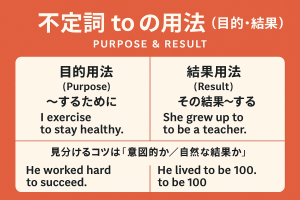
概要と結論
不定詞 to + 動詞の原形 にはいくつかの用法がありますが、ここでは特に 目的用法 と 結果用法 を解説します。
- 目的用法:~するために
- 結果用法:その結果~する
見分けるコツは「意図的か/自然な結果か」です。
不定詞 to の目的用法
意味
「~するために」。人が意図して行動する目的を表します。
例文
- I study hard to pass the exam.(試験に合格するために勉強する)
- She went to the store to buy some milk.(牛乳を買うために店へ行った)
- He got up early to catch the first train.(始発に乗るために早起きした)
不定詞 to の結果用法
意味
「その結果~する」。意図せずに生じた結果や成り行きを表します。
例文
- He lived to be ninety.(彼は結果として90歳まで生きた)
- I awoke to find myself in the hospital.(目が覚めたら病院にいた=その結果わかった)
- She grew up to be a doctor.(大きくなって結果として医者になった)
目的用法と結果用法の違い
- 目的用法=意図・目的(未来志向)
- 結果用法=成り行き・結果(過去からの帰結)
例: He studied hard to pass the exam.(目的) He woke up to find the bus had left.(結果)
よくある文型と例文
- 目的用法:主語 + 動詞 + to V(意図) e.g., She went out to meet her friends.
- 結果用法:主語 + 動詞 + to V(成り行き) e.g., He came home to discover the door open.
よくある間違い
- すべてを「~するために」と訳してしまう → 結果用法は「その結果」と訳すべき。
- 主語が意図できない場合に目的用法を使う → × He died to be remembered. → ○ He died and came to be remembered.
- to と前置詞 for の混同 → × I went there for buy it. → ○ I went there to buy it.
ミニテスト
次の文の to は「目的用法」か「結果用法」か判別してください。
- She left early to catch the bus.
- He grew up to be a famous singer.
- I got up to find it was raining.
- They study English to travel abroad.
解答を見る
- 目的用法
- 結果用法
- 結果用法
- 目的用法
まとめ:使い分けのコツ
- 意図的行動 → 目的用法(~するために)
- 自然な成り行き → 結果用法(その結果~する)
- 主語が「意図を持てる」場合は目的用法を疑うとよい
よくある質問(FAQ)
- Q. 目的用法と副詞的用法は同じですか?
- はい、目的用法は不定詞の副詞的用法の一種です。
- Q. 結果用法は多いですか?
- 頻度は高くありませんが重要な定型表現(live to be, wake to find)が多いです。
- Q. for to V は使えますか?
- 現代英語では基本的に使いません(古英語表現)。正しくは to V のみ。
- Q. 「only to V」って何ですか?
- 「~したが、その結果~しただけ」という残念な結果を表します。例:He hurried only to miss the train.
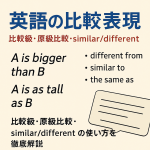


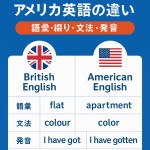


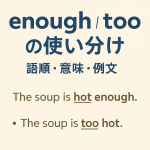
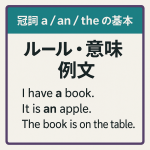
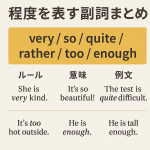
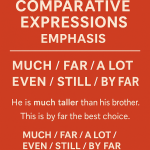
Comments